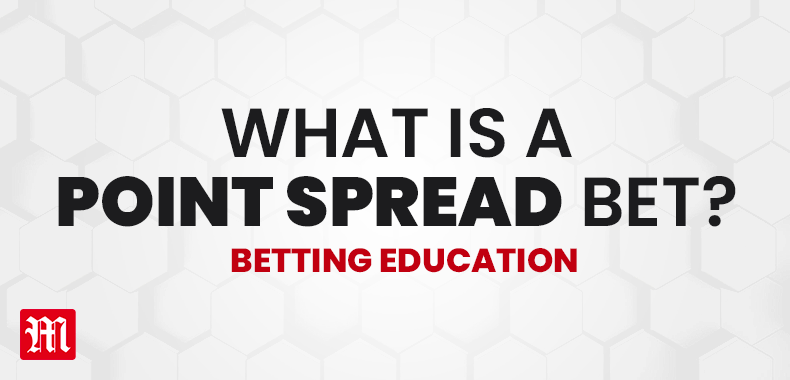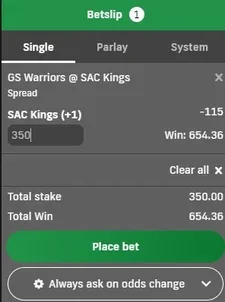Point spread betting is a unique and exciting way to bet on sports, and some sports lend themselves particularly well to this type of wagering.
Wondering which sports we’re talking about? Check out our breakdown below of the most popular sports for point spread betting.
 NFL - The NFL is one of the most popular sports leagues in the world and it’s no surprise that betting on the point spread is a favourite among fans due to the nature of the sport, in which many of the games end up being very close. For example, in a matchup between the Buffalo Bills and Miami Dolphins, the point spread might be Bills -6.5, meaning they need to win by at least seven points to cover the spread.
NFL - The NFL is one of the most popular sports leagues in the world and it’s no surprise that betting on the point spread is a favourite among fans due to the nature of the sport, in which many of the games end up being very close. For example, in a matchup between the Buffalo Bills and Miami Dolphins, the point spread might be Bills -6.5, meaning they need to win by at least seven points to cover the spread.
 NHL - While NHL games can be a low-scoring affair, the point spread is still a popular bet because it can often even the playing field between teams, making for more exciting and competitive games. For example, in a game between the Toronto Maple Leafs and Montreal Canadiens, the point spread might be Canadiens +1.5, meaning they can lose by one goal and still cover the spread.
NHL - While NHL games can be a low-scoring affair, the point spread is still a popular bet because it can often even the playing field between teams, making for more exciting and competitive games. For example, in a game between the Toronto Maple Leafs and Montreal Canadiens, the point spread might be Canadiens +1.5, meaning they can lose by one goal and still cover the spread.
 NBA - The NBA is another hugely popular sport for point spread betting, and for good reason. The fast-paced nature of the game means that even big leads can be quickly eroded, making the point spread an attractive bet. For example, in a game between the Denver Nuggets and the Oklahoma City Thunder, the point spread might be Nuggets -7.5, meaning they need to win by at least eight points to cover the spread.
NBA - The NBA is another hugely popular sport for point spread betting, and for good reason. The fast-paced nature of the game means that even big leads can be quickly eroded, making the point spread an attractive bet. For example, in a game between the Denver Nuggets and the Oklahoma City Thunder, the point spread might be Nuggets -7.5, meaning they need to win by at least eight points to cover the spread.
 MLB - Baseball may not seem like an obvious choice for betting on the point spread, but it’s actually quite popular. The reason for this is that games can be fairly high-scoring, at leeast in contrast to the NHL, for example, and the point spread adds an additional layer of excitement. An example would be if there was a game between the New York Yankees and San Diego Padres, and the point spread was Yankees -1.5. This indicates that they would need to win by at least two runs to cover the spread.
MLB - Baseball may not seem like an obvious choice for betting on the point spread, but it’s actually quite popular. The reason for this is that games can be fairly high-scoring, at leeast in contrast to the NHL, for example, and the point spread adds an additional layer of excitement. An example would be if there was a game between the New York Yankees and San Diego Padres, and the point spread was Yankees -1.5. This indicates that they would need to win by at least two runs to cover the spread.
 College Football - College football is hugely popular across north America and point spread bets are a major part of the sport. With so many games on the schedule each week, there are plenty of opportunities for fans to get in on the action. An example would be if the Alabama Crimson Tide and the Georgia Bulldogs were playing and the point spread was set at Georgia -3.5. This means that the Bulldogs would need to win by at least four points to cover the spread.
College Football - College football is hugely popular across north America and point spread bets are a major part of the sport. With so many games on the schedule each week, there are plenty of opportunities for fans to get in on the action. An example would be if the Alabama Crimson Tide and the Georgia Bulldogs were playing and the point spread was set at Georgia -3.5. This means that the Bulldogs would need to win by at least four points to cover the spread.
 College Basketball - Lastly, we have college basketball, which is another extremely popular sport to wager on regarding the point spread. Much like college football, there are so many games happening each week and with the NCAA tournament being one of the biggest sporting events in the world, there’s no shortage of excitement year-round. An example of what you might see would be if the Duke Blue Devils and the North Carolina Tar Heels were battling it out and the point spread was set at Blue Devils -2.5. This shows that Duke would need to win by at least three points to cover the spread.
College Basketball - Lastly, we have college basketball, which is another extremely popular sport to wager on regarding the point spread. Much like college football, there are so many games happening each week and with the NCAA tournament being one of the biggest sporting events in the world, there’s no shortage of excitement year-round. An example of what you might see would be if the Duke Blue Devils and the North Carolina Tar Heels were battling it out and the point spread was set at Blue Devils -2.5. This shows that Duke would need to win by at least three points to cover the spread.


.jpeg)




 NFL - The
NFL - The  NHL - While
NHL - While  NBA - The
NBA - The  MLB - Baseball may not seem like an obvious choice for betting on the point spread, but it’s actually quite popular. The reason for this is that games can be fairly high-scoring, at leeast in contrast to the NHL, for example, and the point spread adds an additional layer of excitement. An example would be if there was a game between the New York Yankees and San Diego Padres, and the point spread was Yankees -1.5. This indicates that they would need to win by at least two runs to cover the spread.
MLB - Baseball may not seem like an obvious choice for betting on the point spread, but it’s actually quite popular. The reason for this is that games can be fairly high-scoring, at leeast in contrast to the NHL, for example, and the point spread adds an additional layer of excitement. An example would be if there was a game between the New York Yankees and San Diego Padres, and the point spread was Yankees -1.5. This indicates that they would need to win by at least two runs to cover the spread. College Football - College football is hugely popular across north America and point spread bets are a major part of the sport. With so many games on the schedule each week, there are plenty of opportunities for fans to get in on the action. An example would be if the Alabama Crimson Tide and the Georgia Bulldogs were playing and the point spread was set at Georgia -3.5. This means that the Bulldogs would need to win by at least four points to cover the spread.
College Football - College football is hugely popular across north America and point spread bets are a major part of the sport. With so many games on the schedule each week, there are plenty of opportunities for fans to get in on the action. An example would be if the Alabama Crimson Tide and the Georgia Bulldogs were playing and the point spread was set at Georgia -3.5. This means that the Bulldogs would need to win by at least four points to cover the spread. College Basketball - Lastly, we have college basketball, which is another extremely popular sport to wager on regarding the point spread. Much like college football, there are so many games happening each week and with the NCAA tournament being one of the biggest sporting events in the world, there’s no shortage of excitement year-round. An example of what you might see would be if the Duke Blue Devils and the North Carolina Tar Heels were battling it out and the point spread was set at Blue Devils -2.5. This shows that Duke would need to win by at least three points to cover the spread.
College Basketball - Lastly, we have college basketball, which is another extremely popular sport to wager on regarding the point spread. Much like college football, there are so many games happening each week and with the NCAA tournament being one of the biggest sporting events in the world, there’s no shortage of excitement year-round. An example of what you might see would be if the Duke Blue Devils and the North Carolina Tar Heels were battling it out and the point spread was set at Blue Devils -2.5. This shows that Duke would need to win by at least three points to cover the spread..jpeg)


























.svg)










